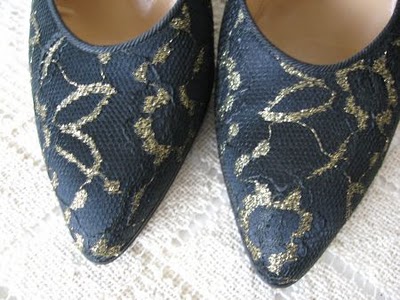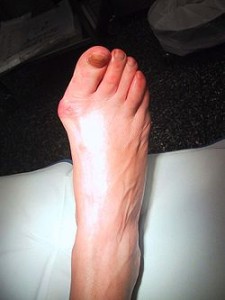Here's a Male Perspective on High Heels
As someone married to a very fashion-oriented wife, I’ve come to know the difference between brands such as Jimmy Choo and Laboutin, as well as some of the other big names. Whenever the awards season rolls around, we get to have the television tuned to the red carpet coverage of all the big events, meaning they throw around outfits that costs more than a Benz and enough jewelry that if liquidated would get the US out of their deficit. It’s also a showcase of medical sciences ability to make [insert any actor or actress name here] still alive and somehow relevant.
One of the other big trends that occurs with these shows is a somewhat creepy fascination with shoe wear. Speaking as someone who wears trainers on a daily basis and flip flops on his off days, I just don’t get the allure of a thousand dollar pair of shoes that’s nothing but a slab of formed wood and about $2 worth of leather that cranks the foot into an ungodly position.
I’m well aware that people will never resort to wearing high heels to do things like squats and lunges, because it’s all situational, but for some reason people will still wear shoes that are so uncomfortable that they wind up spending the second half of the night having someone else hold onto their shoes while they re-apply blister pads or get so blitzed they can’t feel feelings anymore.
So it’s always fun to break the news to women who come in with kneel, hip or low back pain and who commonly wear high heeled shoes that they may have to give them up (if only for a short term) in order to help their areas of discomfort heal up and not suck the life out of them. It tends to go something like this:
Me: So how long has your low bcd been giving you grief?
Woman: Oh, on and off for the past few years. It comes and goes.
Me: Do you do any kind of activities that might cause it?
Woman: I don’t think so. I work in an office, and I have to walk back and forth across the floor a lot, but that’s about it.
Me: Do you wear high heels at work?
Woman: Why yes, I do. But I don’t see how that has any bearing on it.
Me: Would you be willing to switch to some flats or lower heels for a few weeks to see if it helps out? It may be one of the things causing stress through your legs and making your back work too hard and cause some issues.
Woman: ………….
Me: Maybe not?
If we look at fascial anatomy, we can see how the muscles and fascial connections between the gastrocnemius is intimately bound to the hamstrings and through the gluteus into the lumbar spine, as well as through the thoracolumbar fascia. This means that if the ankle is held in a constantly plantar-flexed position, the fascia of the calf will shorten and tighten, making the entire chain pull tight, and restrict movement through the entire chain. Interestingly, whenever I have someone come in with back pain with no known aetiology and who wears high heels a lot, I have them do some ankle mobilizing drills, roll out their lower body fascia, and amazingly their back pain goes away in about 70% of cases.
If the ankle mobility is restricted, another joint has to take up the slack to allow motion to occur. This is the same in any other joint of the body where repetitive overuse or compensation patterns develop.The pressure distribution through the foot is altered, placing the majority of body weight on the ball of the foot and through the transverse arch of the foot versus through the heel and we have altered foot mechanics. Let’s add into the fact that the typical shoe is built completely different from the typical foot in order to achieve a certain “look” and we have a recipe for disaster. Top it off with the fact that a lot of women compensate by walking with an exaggerated anterior tilt and lumbar lordosis, and we have an imbalanced posture to throw into the mix.
The average shoe has an odd point to it, pulling the metatarsals together at a sharp angle that forces the joints to accept more of a valgus stress than normal.
Compare this to a picture of a foot taken by Dr. Jeff Cubos of a female patient who was raised barefoot and on a boat for the first half of her life:
And we can see that there’s going to be a round peg trying to fit into a square hole. As a result of the differences in anatomy and what fashion dictates is beautiful, and we wind up causing a lot of problems such as bunions, corns, valgus separations, bone spur formation, and a whole bunch of other Nasty McAwesomes going on with your footsies.
As a result of this increased risk of dysfunction, when I do an assessment on a new client and I look at their feet, I check the height of their arches, the width of their transverse arch in relation to the length of their foot, and most of the time I’ll simply ask “how long do you spend wearing high heels?” I can usually tell before asking, but it just adds some more credence to the thought process when they tell me they live in high heels for the bulk of their week and they show up with flat arches, collapsed tarsals, and big ole bunions creeping on both big toes.
I normally recommend when someone has some issue with their feet, knees, hips or low back and there’s no known reason why (meaning they didn’t have an acute injury, or its’ repetitive strain from a specific activity), and if they wear high heels for a lot of their week,they should be moving into more of a flat shoe, or at the very least a lower heel that has a wider toe box and isn’t carved into a sharp point. They don’t have to be Birkenstocks or flip flops, but they should at least feel somewhat comfortable.
Now while I’ll admit that the shoes may or may not be the cause of the problem in every case, but they may be one of the pre-disposing concerns that may be leading down the road to problems. For every one person who can walk for ever in heels and never have any foot, knee, hip or low back problems, there’s another dozen or two people who can’t walk with them without having some issues. They may or may not be one of the causes of a lot of issues, so one of the easiest switches you could make is switching from high heels to lower heels or even flats, and changing from a narrow toe box shoe to one with a wider and rounder toe box to allow the toes to move properly without the excessive valgus force.
I’m sure there’s never going to be a time when people completely switch it up and go from high heels to Five Fingers, but there could always be a happy medium. I’m all for someone wearing the heels for special occasions, but there has to be a balance. What are your thoughts? Leave a comment below and let me know what you think about heels and health.



15 Responses to Here's a Male Perspective on High Heels